Elliot Lowell

About the Author
Elliot Lowell is a promising name on the numismatic scene with 20+ years of experience collecting and over 500 collectible relics stored in his vault. Although his passion does not come down to American coinage only, Elliot’s attention has been largely devoted to modern US coins.
Pursuing his dream to turn a hobby into a profession, Lowell earned his Bachelor’s degree in American Studies with a minor in Museum Curation from Saint Michael’s College. As for its current numismatic activity, he writes a regular column for “Coin Heritage Weekly” and has contributed to “The Numismatist” as a member of the American Numismatic Association. And today, we are honored to have Elliot Lowell contribute this original piece, exquisitely prepared for our audience.
Follow Elliot on Social Media



The Birth of the One Dollar Coin 2000
When times change, outstanding creations shall appear.
At the dawn of a new millennium, when crises hit and no one knows what is yet to come, it is always reasonable to encourage the nation and commemorate the contributions of those who are involuntarily left behind.
Dollar coins, the most representative pieces of the American monetary system, have undergone multiple changes since their emergence in 1794. Although one may proclaim it an indispensable piece, its place in the pockets of American citizens was quite unstable. Some issues were too large, while others were never meant to enter general circulation.
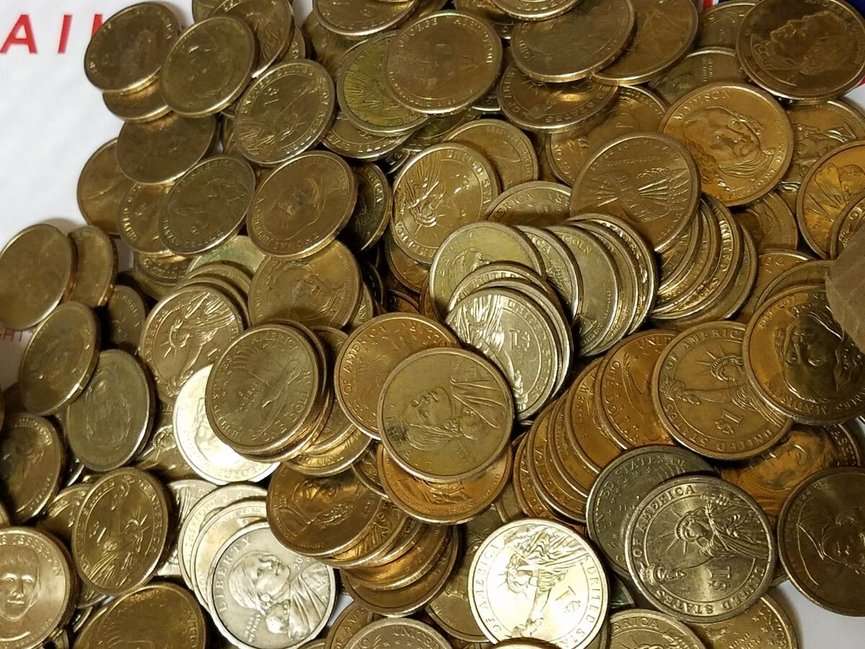
By the late 1990s, it was clear that the US Mint urgently needed to submit a new approach and create a new coin that would perform both functions: serve as a stable, useful unit of currency and capture the spirit of the great country. In 1997, after intense debates regarding designs and proper minting, Congress passed the United States $1 Coin Act* as the fourth section of the larger 50 States Commemorative Coin Program Act, signed by President Bill Clinton.
The solution was ambitious and was initially seen as a fine replacement for the older and yet unpopular Susan B. Anthony 1-dollar coin. However, authorities responsible for monetary policies may be wrong at times. Due to the national habits, Americans remained reluctant to adopt dollar coins over paper bills anyway. Yet, it was not truly about the success of a particular coin but of the whole sector that had to face new challenges and battle trite traditions, pursuing the best.
*According to the Act, a new coin was to be golden in color and unique enough to be easily discernible when compared to other designs or denominations.

Design & Symbolism
The choice of design was the most essential part of the whole initiative. The path to the design of the 2000 1 dollar coin began well before the first piece was ever struck. As per the Act, there were no specified requirements on whom to portray rather than HOW to do it in the most effective way. This came down to composition and edge, but never to its appearance.
Chairmen who were present in the specially gathered Dollar Coin Design Advisory Committee advocated that either Sacagawea (i.e., the Shoshone woman who acted as a guide and interpreter for the Lewis and Clark Expedition) or the Statue of Liberty be depicted, with the latter being an overused symbol of the United States. Due to the fact that the authorities could not make a unanimous decision, the US Mint launched a campaign to gather input on what the new coin should represent.
The decision to feature Sacagawea was historic from the very beginning. In fact, she was meant to become the first Native American woman ever depicted on US currency in regular circulation and only the second real-life woman to appear on a circulating U.S. coin after Susan B. Anthony. The goal was reached, and the design process soon began.
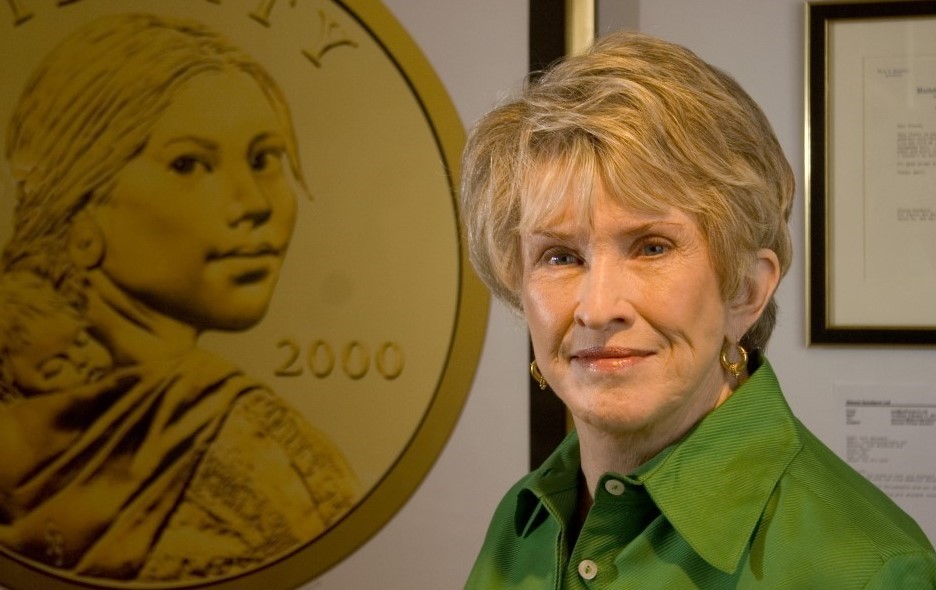
What Does the Gold Dollar Coin 2000 Look Like?
After the intense selection process, which 23 artists took part in, there was commissioned Glenna Goodacre, who followed the guidelines sent by the US Mint and captured the history in the small metal plate.
Obverse Side: On the front side of the 2000 gold dollar coin, Glenna Goodacre displayed Sacagawea carrying her infant son, Jean Baptiste Charbonneau (with Sacagawea being inspired by and based on Randy’L He-dow Teton’s appearance to feature the details of a young Native American woman). It was a powerful gesture, for the issue showed a figure who was a mother, an Indigenous woman, and a guide. The grace is in each detail.
Reverse Side: As for the reverse, it was designed by Thomas D. Rogers Sr. and featured a soaring bald eagle with its wings outstretched in mid-flight and 17 stars composing the ring around it. Unlike the previous designs, the 2000 Sacagawea dollar coin was more of an experimental one, as the eagle was captured in motion, not static or too grandiloquent.
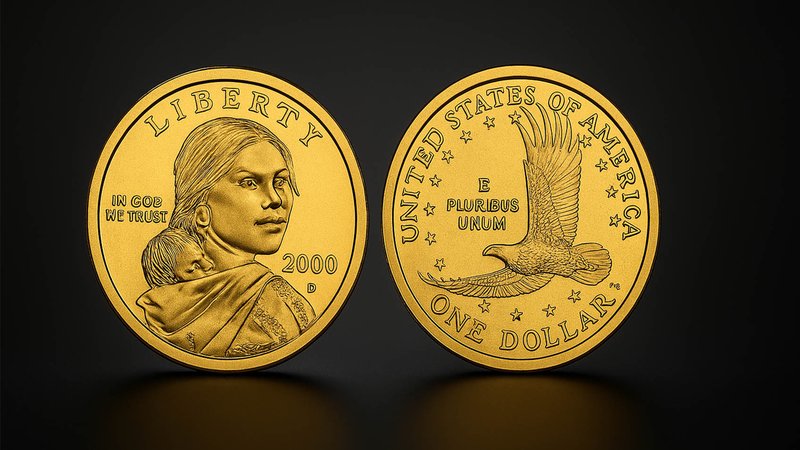
Physical Characteristics
Although the 1-dollar issue of 2000 was to be golden in color, it actually consisted of a golden-colored alloy, made from a blend of copper, zinc, manganese, and nickel. This is how the US Mint strived to make a coin more appealing to use and collect, when compared to other designs or denominations.
| The Main Features of the 2000 Dollar Coin | |
| Obverse | Sacagawea with infant Jean Baptiste by Glenna Goodacre with inscriptions “In God We Trust”, “2000”, mint mark, and “Liberty” above (this is why this issue may sometimes be called a liberty dollar coin 2000) |
| Reverse | Soaring eagle with 17 stars by Thomas D. Rogers Sr. with inscriptions “United States of America”, “E Pluribus Unum”, and “One Dollar” beneath |
| Composition | Manganese-brass (88.5% copper, 6% zinc, 3.5% manganese, 2% nickel) |
| Color | Golden (not made of gold) |
| Diameter | 26.49 mm (1.043 inches) |
| Thickness | 2.00 mm (0.079 inches) |
| Weight | 8.1 grams (0.26 troy oz) |
| Edge | Smooth (plain) |
| Denomination | USD 1 |
| Mint Marks | “P” for Philadelphia“D” for Denver“S” for San Francisco |
Varieties of 2000 One Dollar Coins from the Philadelphia Mint
2000 P Dollar Coin
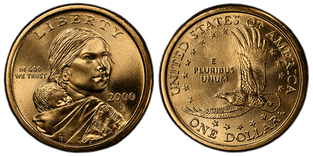
Produced by: Philadelphia Mint
Mintage: 767,140,000
Auction Record: $117,500 for MS67
This is the standard circulation strike from Philadelphia, the most common of all issues released in 2000. Although it was widely distributed all across the country, certain specimens of high quality (like those with Mint States grades) may be worth thousands of dollars as the first issue with a collectible potential to rise.
2000 P Cheerios Dollar (Prototype Reverse)
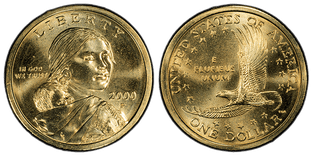
Produced by: Philadelphia Mint
Mintage: ~5,500 distributed
Auction Record: $27,600 for MS69
Sometimes, the US Mint may make unexpected, unconventional decisions and promote coins through other products of general use. For instance, this coin was included in Cheerios boxes as part of a millennium celebration campaign with a distinctive prototype reverse, which can be easily observed in the eagle’s tail feathers. The Cheerios most valuable 2000 P Sacagawea dollar coin value is quite outstanding – it may reach dozens of thousands, with a tendency to grow over time.
2000 P Goodacre Presentation Dollar
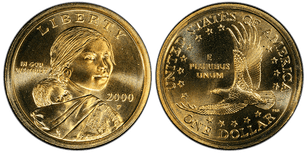
Produced by: Philadelphia Mint
Mintage: 5,000
Auction Record: $5,288 for SP69
Last but not least, here is one of 5,000 Sacagawea dollar coins 2000-P that were given to their designer, Glenna Goodacre, as compensation for her obverse design. At first, they were thought to be the same as those struck for general circulation afterward. However, these were hand-polished, with a satin-like finish. This is how the 2000 dollar coin value can be uplifted, even after a few years of release.
Other Notable Coin Types
2000 D Dollar Coin

Produced by: Denver Mint
Mintage: 518,916,000
Auction Record: $25,875 for MS67
As a rule, original creations tend to become worthiest when it is high time. Instances produced by Denver could boast the second highest mintage for circulation strikes, with the most valuable 2000-D Sacagawea dollar coin value being not as impressive as those of more exclusive coins. Anyway, it is all about the condition of the item rather than its rarity or special attributes (that still matter).
2000 D Millennium Set Coin

Produced by: Denver Mint
Mintage: 75,000
Auction Record: $863 for MS68
Released under the US Mint’s special Millennium Coin & Currency Set, this instance has been initially created for those who appreciate numismatic creations most of all – collectors. Each set included three key items: a 2000 $1 Federal Reserve Note, a 2000 Uncirculated American Silver Eagle, and the Denver-minted Sacagawea dollar, with the first retail price of $39. Indeed, the one dollar coin 2000 value was not really high at that time.
2000 S Sacagawea Dollar (Proof)
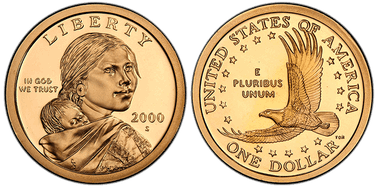
Produced by: San Francisco Mint
Mintage: 4,047,904
Auction Record: $3,600 for PR70
Proofs are overly polished creations with a deep mirror-like background and frosted details, always intended for collectors who see their value in preservation in exquisite designs. And yes, this variety cannot be considered one of the most sought-after or coveted pieces to obtain. Nevertheless, it may be potentially worth a few hundred, though.
2000-W Sacagawea $1

Produced by: Philadelphia Mint (with West Point “W” mint mark)
Mintage: 12 surviving examples out of 39 in total
Auction Record: $70,500 for PR70
In 1999, there was conducted an experiment. The US Mint 39 struck 39 proof Sacagawea dollars using 22-karat gold planchets, i.e., the same .9167 fine gold blanks used for $25 American Gold Eagles. Although these were physically struck at the Philadelphia Mint, they bear the “W” mint mark intended for West Point, their originally planned production site.
After evaluation, the Mint retained only 12 of the finest examples for display and melted the remaining 27, which boosted the worth and made it the most valuable piece so far.
Notable Errors That Have Changed the Game
Coins are not perfect. Though their appearance may be deviated, this should not be considered a flaw. Instead, one is to pay special attention to those numismatic creations that bear errors, for they are unique, exclusive, and one-of-a-kind. The gold dollar coin value 2000 grows, and errors turn into heroes we all love.
Here are the most notable instances to look for.
2000 P Mule with State 25C Obverse
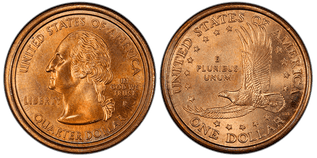
Produced by: Philadelphia Mint
Mintage: Estimated fewer than 20 known
Auction Record: $192,000 for MS67
This is the legendary modern mint error with a Washington quarter obverse die that was accidentally paired with the reverse of the original 2000 P Sacagawea one dollar coin. The result is a true mule, i.e., an illegal die pairing. Each instance that has been discovered bears a signature attribution, e.g., the “Margolis” specimen or the “Greg Senske” specimen (with these attributions referring to either their past owners or the platform it was sold).
2000 P “Wounded Eagle”

Produced by: Philadelphia Mint
Mintage: Unknown
Auction Record: $4,000+ for MS67
Here is one more deviation that appears on the 2000 P one dollar coins only. A dramatic die gouge on the reverse grants the appearance of being pierced by a spear or arrow. This might be perceived as a representation of the fragility of even the most powerful systems that do have weak spots with no other formidable counterpart.
2000 D Mule with South Carolina 25C Reverse

Produced by: Denver Mint
Mintage: Unknown (extremely limited)
Auction Record: $66,000 for MS64
Although not Philadelphia-born, this reported mule features a Sacagawea obverse with a South Carolina quarter reverse (from the “50 State Quarters” program, enacted December 1, 1997). When the authenticity of the Liberty one dollar coin 2000 is confirmed, it may rival the 2000 P mule in rarity and significance. However, auction records may not reflect this tendency to prefer rarer options over those that are more common.
How Much Is a 2000 Dollar Coin Worth? Then and Now
As soon as the issue was released, the 2000 one dollar coin value had already become the subject of speculation. Although it only increases over time, general price ranges may demonstrate how precious the item is to be. Here is a table that demonstrates average pricing trends that may define the true 2000 gold dollar coin value:
| Variety | Mint Mark | Estimated Value Range |
| Standard Circulation Strike | P or D | $1 – $10 |
| 2000-D Millennium Set Dollar | D | $5 – $50 |
| 2000-S Proof | S | $10 – $30 (PR68–69); up to $300 (PR70) |
| 2000-P “Wounded Eagle” | P | $100 – $500+ |
| 2000-P “Cheerios” Dollar | P | $2,500 – $7,000+ |
| 2000-P Goodacre Presentation | P | $350 – $1,200 |
| 2000-W 22kt Gold Proof | W | $50,000 – $75,000+ |
| 2000-P Mule w/ State Quarter Obverse | P | $100,000 – $200,000+ |
| 2000-D Mule with South Carolina Quarter Reverse | D | N/A |
Note: Auction prices for rare coins often exceed the typical market $1 dollar gold coin value 2000 due to competitive bidding, unique provenance, or other unpredictable factors, too. Records taken from auctions should not serve as a standard, but a fine 2000 gold dollar coin value chart with relevant data to take into consideration (but nothing more).
A Golden Promise Kept?
The legacy of $1 coins will always grow. No matter how widespread coins can be, it is about their appearance, i.e., those featured and commemorated through numismatic art. And exploring the world of coins can be a bit complicated at first.
Should you wish to learn more about the true one dollar coin 2000 P value, it might be vital to use additional tools like Coin ID Scanner that can instantly help you identify coins, determine their potential value, detect errors, store them in your digital collection, and discover whether they are standard or unique.
Using advanced image recognition technologies supported by a large coin database, the app delivers quick, well-detailed results through only one photo you take. Wondering about the 2000 P Sacagawea dollar coin value? Snap, wait, and learn. It is a modern solution for those who care about numismatics but cannot decide where to start.
In a world of forgotten relics, these are ways where discoveries begin…